(Image credit: Jonathan Bachman/Reuters)
For International Women’s Day, 12 iconic photos of female defiance, including the woman who handbagged a neo-Nazi and the marchers who sparked the Russian Revolution.
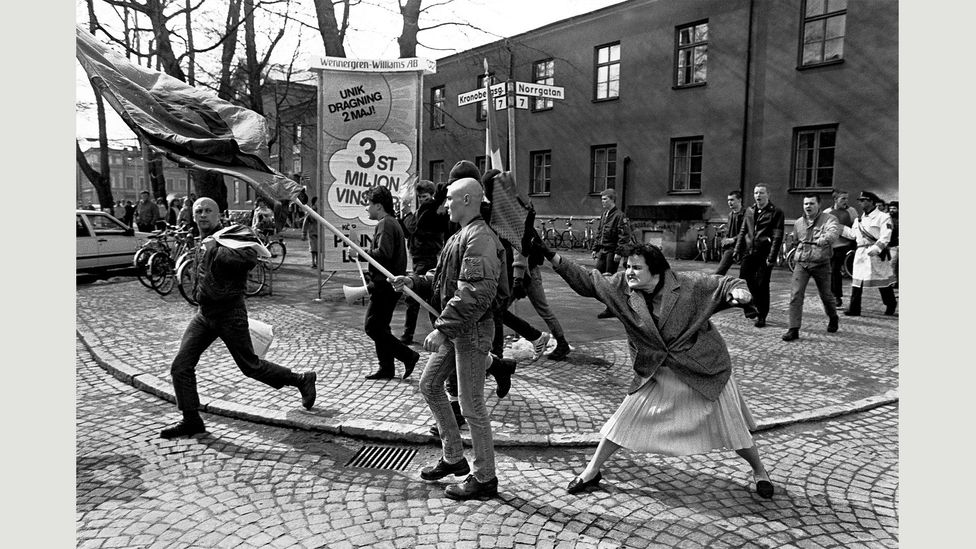

1. Danuta Danielsson, Sweden, 1985
Swedish photographer Hans Runesson captured this moment on 13 April 1985 – and his image has endured since, voted Picture of the Century and resurfacing on social media in 2016 with the call to arms: “Be the woman hitting a neo-Nazi with a handbag you wish to see in the world”. Taken in Växjö, Sweden during a demonstration by the neo-Nazi Nordic Reich Party, the photo shows 38-year-old Danuta Danielsson swiping at one of the marchers with her handbag.
The Polish-Swedish passerby, whose family members had reportedly been sent to a Nazi concentration camp, snapped “impulsively”, according to Runesson, who told BBC Culture that the man did “nothing – he walked further” afterwards. Despite the incident happening in a fleeting instance, the photo continues to resonate for many as a silent rallying cry.
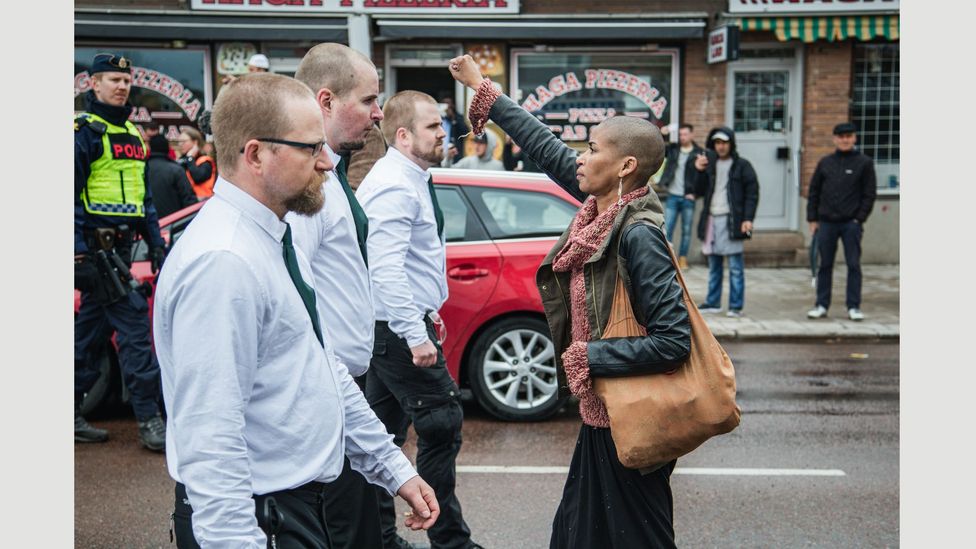

(Credit: David Lagerlöf/Expo/TT News Agency/Press Association Images)
2. Tess Asplund, Sweden, 2016
And it had an eerie parallel in 2016, when social activist Tess Asplund placed herself in the path of protesters from the Nordic Resistance Movement in Sweden. David Lagerlöf snapped the instant when the social activist confronted a May Day march of 300 uniformed nationalists in Borlänge, Sweden: fist clenched, her impassive stance communicated as much as countless violent encounters.


(Credit: Jonathan Bachman/Reuters)
3. Ieshia Evans, US, 2016
Standing still, her dress fluttering, as two police officers in full riot gear approach her, a woman protester in Baton Rouge, Louisiana made the headlines with a similarly resolute body language when this image was taken in 2016. Hailed as an “instant classic”, the photo of Ieshia Evans being arrested at a Black Lives Matter protest was compared with Stuart Franklin’s image of “Tank Man” at Tiananmen Square or the picture of an anti-Vietnam War demonstrator placing flowers in police officer’s gun barrels.
Immobile, composed, Evans is like the calm at the eye of a storm – her comment above a Facebook post of the image was: “I appreciate the well wishes and love, but this is the work of God. I am a vessel!” Taken by the photographer Jonathan Bachman, it has been seen by some as a symbol of peaceful defiance. A nurse, Evans travelled to Baton Rouge to protest the fatal police shooting of Alton Sterling, telling The Guardian: “I have a six-year-old son, Justin, and I fear more for his life than I do for my own. How should I raise him? To be afraid? To keep his head down and not get in trouble… Or do I raise him in strength?”
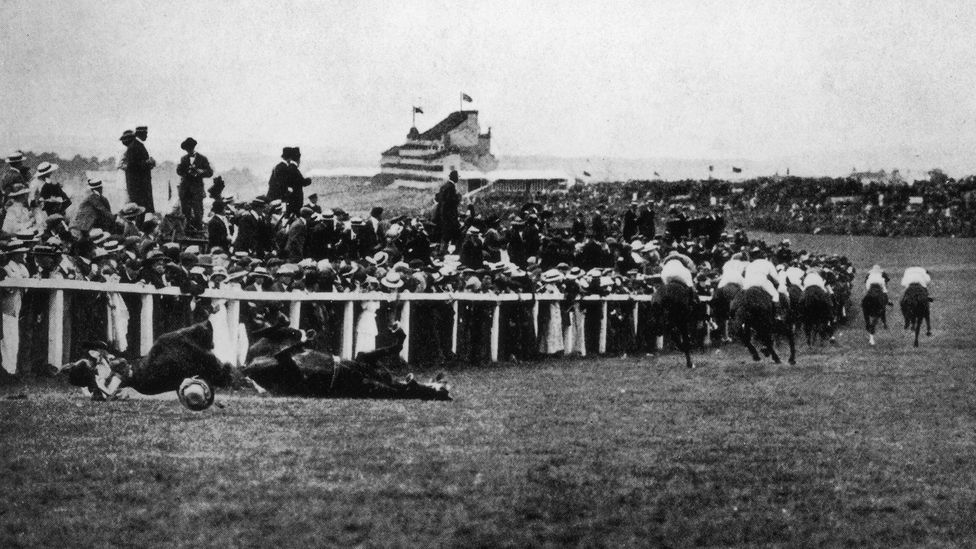

4. Emily Wilding Davison, UK, 1913
One photo taken more than a century ago reveals an act of defiance that didn’t end peacefully. Suffragette Emily Wilding Davison died when she stepped in front of the King’s horse Anmer, during the Epsom Derby of 1913. Recent analysis of footage captured on newsreel cameras appears to suggest she was attempting to attach a scarf to the horse’s bridle – yet whatever her intention, Davison has been hailed by some as a martyr, and an emblem of female emancipation.
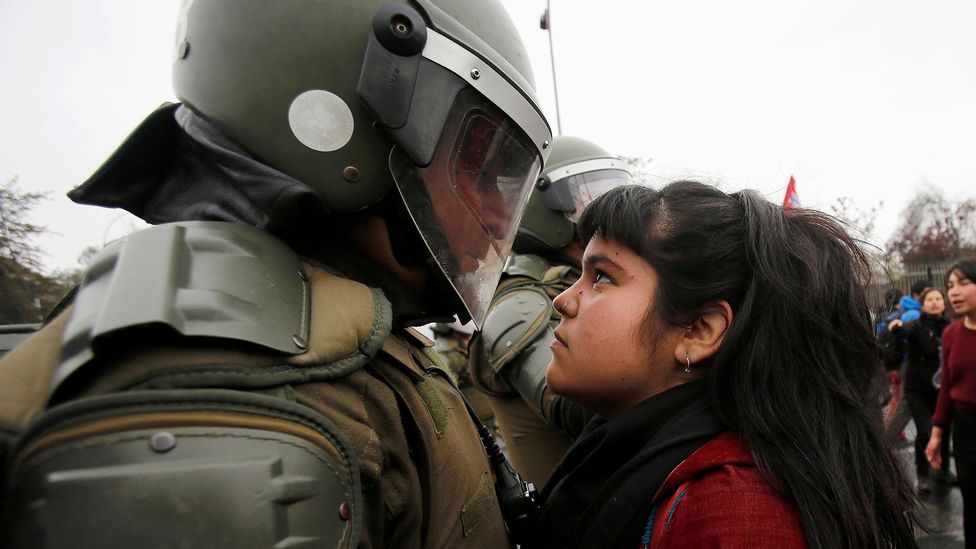

(Credit: Carlos Vera/Reuters)
5. Anti-government protests, Chile, 2016
Photographed by Carlos Vera Mancilla in 2016, this photo reveals the visual power of an individual stance. Taken at demonstrations marking the 43rd anniversary of the military coup that resulted in the overthrow of President Salvador Allende by Augusto Pinochet on 11 September 1973, the image captures the full force of a glare.
Outside the General Cemetery of Santiago – the site of Allende’s grave, and a memorial to those “disappeared” during Pinochet’s regime – an unnamed female protester squared up to a riot policeman, staring unflinchingly through his visor.
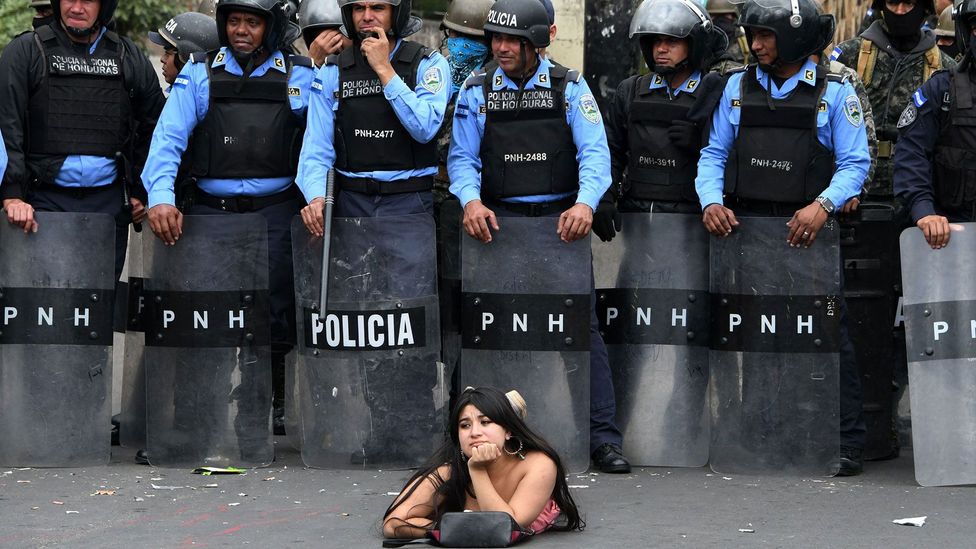

6. Protest against a contested re-election, Honduras, 2017
Another photo, taken in the Honduran city of Tegucigalpa in 2017, shows a less confrontational form of defiance: lying down. A supporter of the defeated presidential candidate Salvador Nasralla, protesting the contested re-election of President Juan Orlando Hernández, lay on the pavement in front of riot police – her seeming nonchalance in fact a display of inner strength.
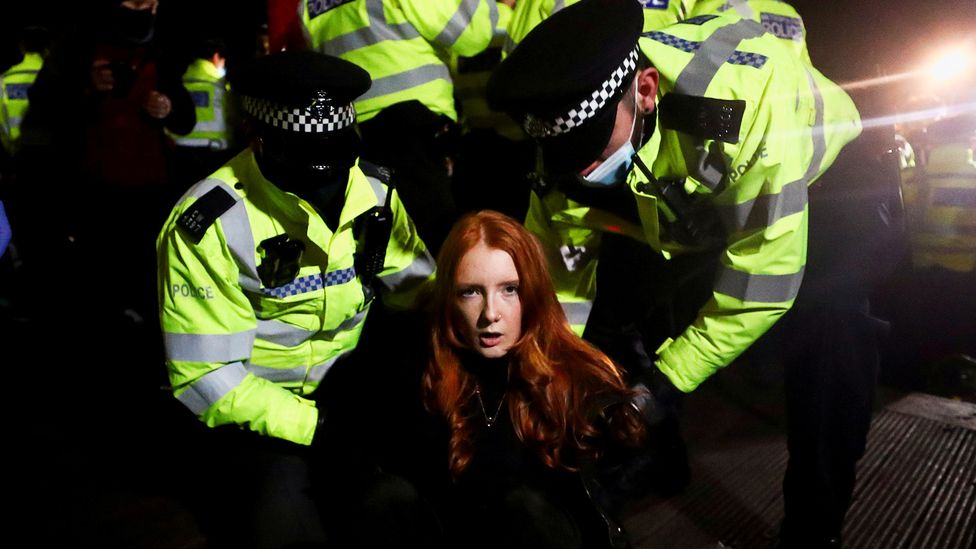

Patsy Stevenson (Credit: Hannah McKay/Reuters)
7. Sarah Everard vigil, UK, 2021
A photo taken at a candlelit vigil was shared widely in 2021, as women were seen being handcuffed and led away by police officers. The event at London’s Clapham Common was planned in tribute to Sarah Everard, who had been kidnapped, raped and murdered by police officer Wayne Couzens. While organisers aimed for it to be socially distanced, the vigil was cancelled after police said it would be illegal under lockdown restrictions. Patsy Stevenson, the woman in this photo, later told the BBC that, moments before their arrest, a small group of women found themselves stuck against some railings. “People assume that I was part of the organisation or part of a protest group, but I had never even been to a protest before… We sort of just all in solidarity just stayed there.”
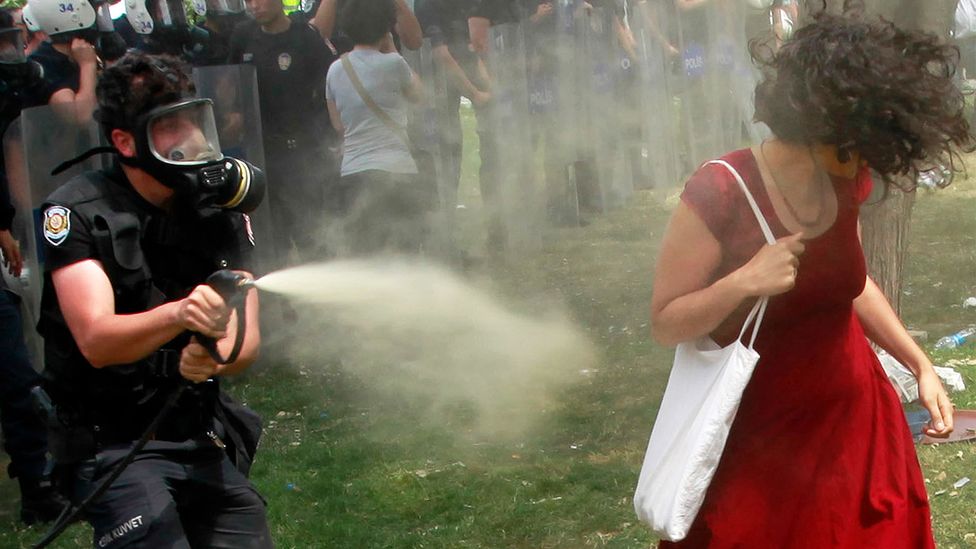

Ceyda Sungur (Credit: Osman Orsal/Reuters)
8. The Woman in Red, Turkey, 2013
Taking part in protests at Gezi Park in Istanbul one day in May 2013, Ceyda Sungur found herself facing a bank of riot police. When one of them fired tear gas at her, Reuters photographer Osman Orsal captured the moment, creating an image that became an emblem of the resistance movement sweeping Turkey that summer. Sungar – later labelled “the woman in red” – was injured, but she was a reluctant figurehead, saying: “A lot of people no different from me were out protecting the park, defending their rights, defending democracy,” she said. “They also got gassed.”
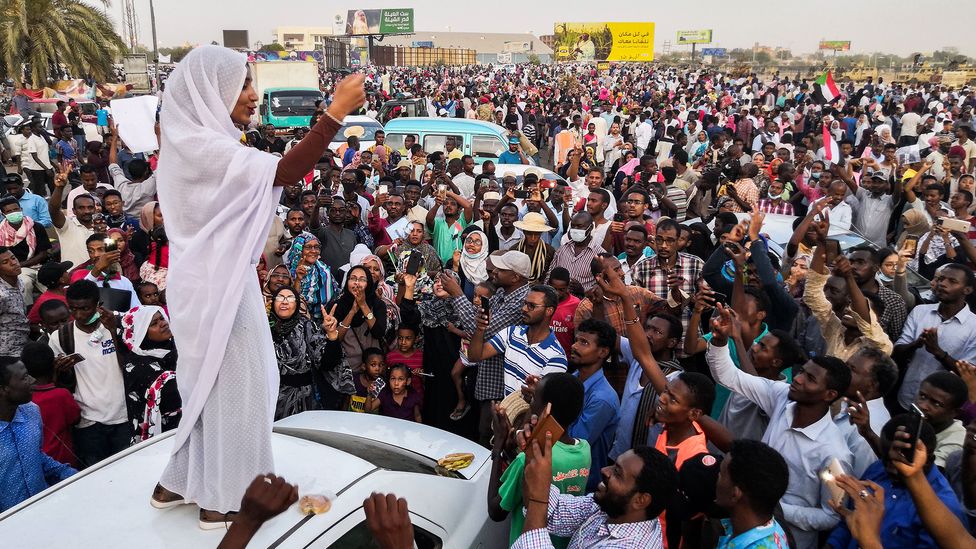

Alaa Salah (Credit: Getty Images)
9. Anti-government protest, Sudan, 2019
After street protests broke out in December 2018, demonstrations swept through Sudan. At a protest in March 2019 outside the presidential palace, 22-year-old architecture student Alaa Salah was photographed leading chants against the Omar al-Bashir regime from atop a car. She emerged as a symbol of what became the revolution, bringing global attention to what was happening in the country. “I didn’t expect to be called the icon of the revolution,” she told the BBC, “and I don’t claim that I’m the icon of the revolution. On the contrary, all Sudanese people are the icon of the revolution.” BBC journalist Zeinab Badawi said that women “made a contribution that is equal to that of the men in helping to dislodge President Bashir from power, and they’ve made it clear that they won’t be bowing out of public life now that he’s gone.”


10. Greenham Common, UK, 1982
In September 1981, 36 women chained themselves to a fence at a US military airbase in Berkshire, England. They were protesting the decision of the British government to allow nuclear cruise missiles to be sited at RAF Greenham Common – and they established a peace camp that remained there for 19 years.
In 1982, it was decided that the camp should involve women only, creating a collective identity as mothers to protest in the name of all future generations. On 12 December 1982, 30,000 women held hands around the 6 miles (9.7 km) perimeter of the base (pictured); a year later, 50,000 women attended.
Hiroko Hatakeyama, who survived the bombing of Hiroshima, went to the peace camp. “I believe there’s a connection between what the women at Greenham did and the recent women’s marches around the world,” she told The Guardian.
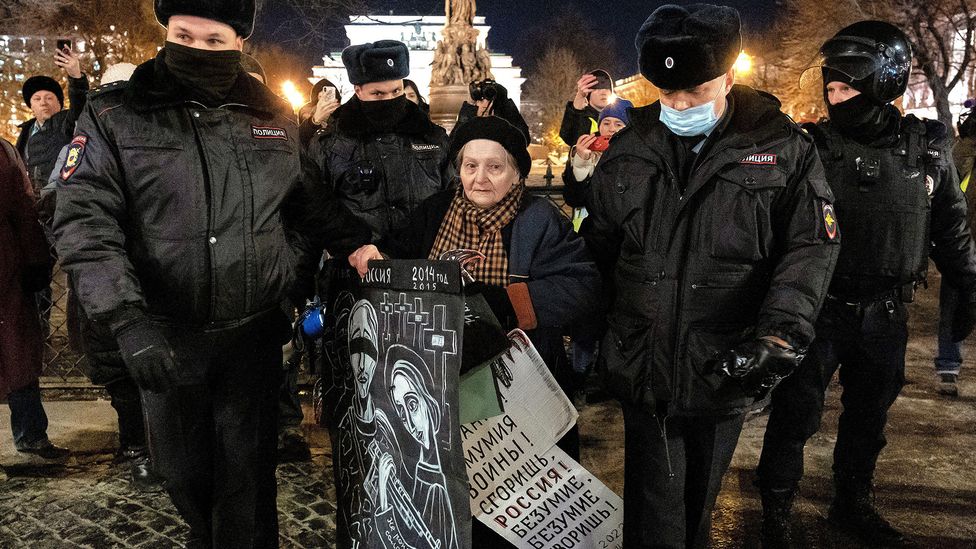

Russian activist Yelena Osipova (Credit: Alamy)
11. Yelena Osipova, Russia, 2022
The 78-year-old Russian artist and activist Yelena Osipova began protesting in 2002, over the years calling for freedom for political prisoners and opposing Russian intervention in Ukraine after its Maidan revolution. Since the outbreak of the Russia-Ukraine war in 2022, she has been a regular presence on the streets of St Petersburg, picketing for peace. Despite being arrested multiple times for her protests, she told The Moscow Times that occasionally police officers simply take photos of her protest signs before letting her go. Osipova’s parents survived the Siege of Leningrad during World War Two, but one of her grandfathers died of hunger – and she is keen that people learn from history, telling El País: “Indifference, silence – that’s the most terrible thing that could happen. On a poster I wrote: ‘All of this happened because you stayed silent.'”
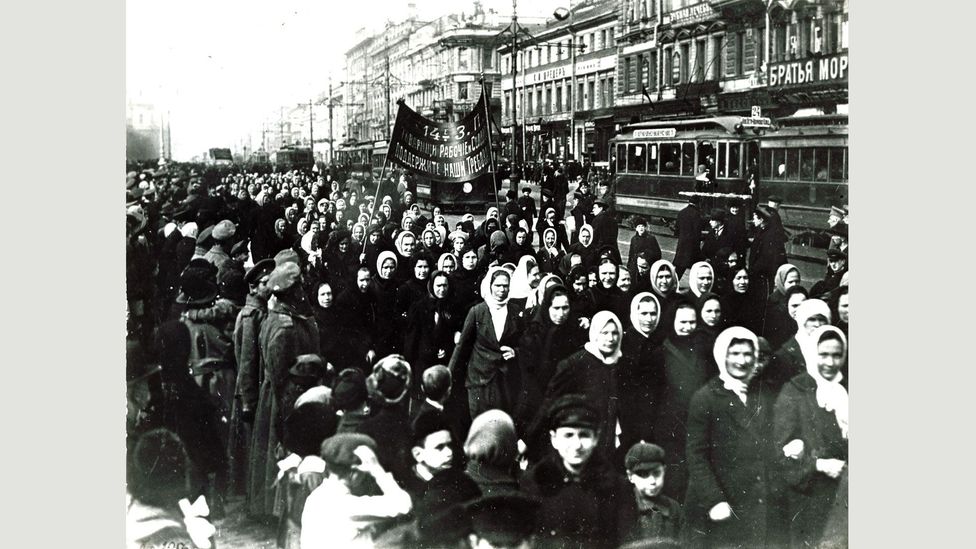

12. International Women’s Day march, Russia, 1917
Images of events such as Slutwalk, Take Back the Night and the Women’s March on Washington have reflected strength in unity in recent decades. Yet there’s perhaps one women’s march that had more far-reaching impact than any other.
This photo shows women marching in St Petersburg on 8 March 1917. The date (23 February in the old Russian calendar) marked International Women’s Day, an important day in the socialist calendar – and, now, it also commemorates the first day of the Russian Revolution. While the marchers carried placards that had patriotic slogans, they also demanded change like “Feed the children of the defenders of the motherland” or “Supplement the ration of soldiers’ families, defenders of freedom and the people’s peace”.
“By midday of that day in 1917 there were tens of thousands of mainly women congregating on the Nevsky Prospekt, the principal avenue in the centre of the Russian capital, Petrograd,” writes Orlando Figes, author of A People’s Tragedy: The Russian Revolution. On the following day, protesters had scaled the statue of Alexander III in Znamenskaya Square, calling for the downfall of the monarchy. And a week later, Tsar Nicholas II abdicated the throne. The women’s march had become a revolution.
If you liked this story, sign up for The Essential List newsletter – a handpicked selection of features, videos and can’t-miss news delivered to your inbox every Friday.
If you would like to comment on this story or anything else you have seen on BBC Culture, head over to our Facebook page or message us on Twitter.
;

